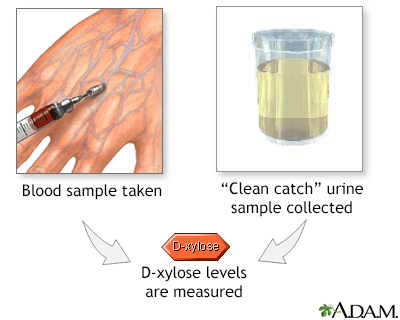Pregnancy SmartSiteTM
Xylose tolerance test; Diarrhea - xylose; Malnutrition - xylose; Sprue - xylose; Celiac - xylose DefinitionD-xylose absorption is a laboratory test to check how well the intestines absorb a simple sugar (D-xylose). The test helps detect if nutrients are being properly absorbed. How the Test is PerformedThe test requires a blood and urine sample. These tests include: There are several ways to perform this test. A typical procedure is described below, but make sure you follow the specific instructions you are given. You will be asked to drink 8 ounces (240 ml) of water that contains 5 teaspoons (25 grams) of a sugar called d-xylose. The amount of d-xylose that comes out in your urine over the next 5 hours will be measured. You may have a blood sample collected at 1 and 3 hours after drinking the liquid. In some cases, the sample may be collected every hour. The amount of urine you produce over a 5-hour period is also checked. Your health care provider will tell you how to collect all of the urine during a 5-hour period. How to Prepare for the TestDo not eat or drink anything (even water) for 8 to 12 hours before the test. Your provider will ask you to rest during the test. A failure to restrict activity may affect test results. Your provider may tell you to stop taking certain medicines that can affect test results. Medicines that can affect test results include aspirin, atropine, indomethacin, isocarboxazid, and phenelzine. DO NOT stop taking any medicine without first talking to your provider. How the Test will FeelWhen the needle is inserted to draw blood, you may feel moderate pain, or only a prick or stinging sensation. Afterward, there may be some throbbing. Urine is collected as part of normal urination with no discomfort. Why the Test is PerformedYour provider may order this test if you have:
This test is primarily used to check if nutrient absorption problems are due to a disease of the intestines. It is performed much less often than in the past. Normal ResultsA normal result depends on how much D-xylose is given. In most cases, the test results are either positive or negative. A positive result means that D-xylose is found in the blood or urine and is therefore being absorbed by the intestines. Normal value ranges may vary slightly among different laboratories. Some labs use different measurements or test different samples. Talk to your provider about the meaning of your specific test results. What Abnormal Results MeanLower than normal values may be seen in:
RisksThere is little risk involved with having your blood taken. Veins and arteries vary in size from one person to another and from one side of the body to the other. Taking blood from some people may be more difficult than from others. Other risks associated with having blood drawn are slight, but may include:
ConsiderationsMultiple tests may be necessary to determine the reason for malabsorption. ReferencesFloch MH. Evaluation of the small bowel. In: Floch MH, ed. Netter's Gastroenterology. 3rd ed. Philadelphia, PA: Elsevier; 2020:chap 62. Semrad CE. Approach to the patient with diarrhea and malabsorption. In: Goldman L, Cooney KA, eds. Goldman-Cecil Medicine. 27th ed. Philadelphia, PA: Elsevier; 2024:chap 126. Siddiqi HA, Rabinowitz S, Axiotis CA. Laboratory diagnosis of gastrointestinal and pancreatic disorders. In: McPherson RA, Pincus MR, eds. Henry's Clinical Diagnosis and Management by Laboratory Methods. 24th ed. St Louis, MO: Elsevier; 2022:chap 23. | ||
| ||
Review Date: 3/31/2024 Reviewed By: Jenifer K. Lehrer, MD, Department of Gastroenterology, Aria - Jefferson Health Torresdale, Jefferson Digestive Diseases Network, Philadelphia, PA. Review provided by VeriMed Healthcare Network. Also reviewed by David C. Dugdale, MD, Medical Director, Brenda Conaway, Editorial Director, and the A.D.A.M. Editorial team. View References The information provided herein should not be used during any medical emergency or for the diagnosis or treatment of any medical condition. A licensed medical professional should be consulted for diagnosis and treatment of any and all medical conditions. Links to other sites are provided for information only -- they do not constitute endorsements of those other sites. No warranty of any kind, either expressed or implied, is made as to the accuracy, reliability, timeliness, or correctness of any translations made by a third-party service of the information provided herein into any other language. © 1997- A.D.A.M., a business unit of Ebix, Inc. Any duplication or distribution of the information contained herein is strictly prohibited. | ||


 Male urinary syste
Male urinary syste D-xylose level tes...
D-xylose level tes...
